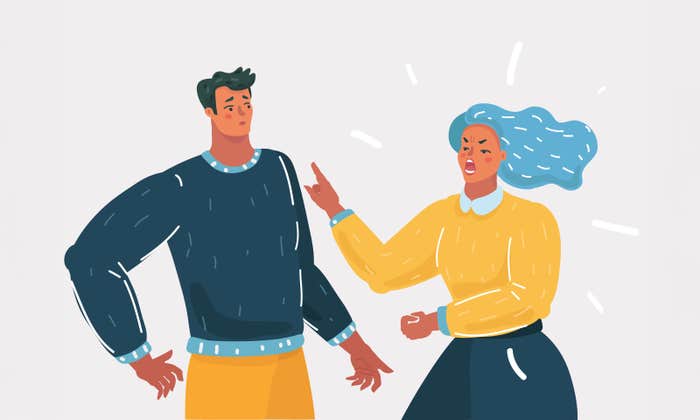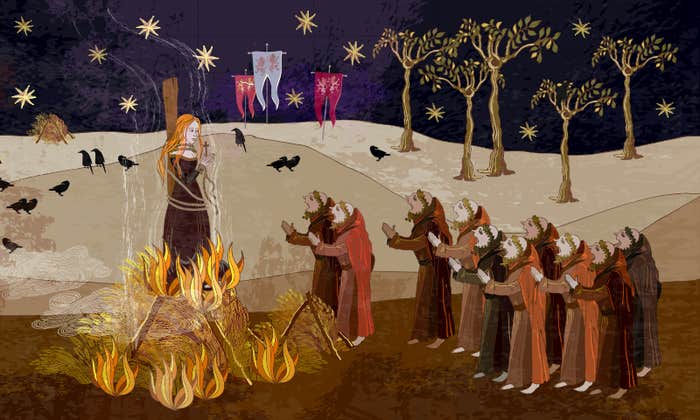Cailin O’Connor—a philosopher, scientist, and mathematician—may not enjoy tense situations, but they fascinate her. Last year, in a Huffington Post article titled “Game Theory and The Walking Dead,” she wrote that the zombie show’s “plot lines are rich with strategic tension.” She goes on to analyze three of what she calls “the most strategically compelling scenes,” and seems to relish in the fact that the characters—since they so often die—aren’t great game theorists. (Game theory, as she sometimes has to remind her students at the University of California, Irvine, isn’t really about games, but about predicting rational behavior.)
Recently, she’s brought this sort of scrutiny on the behavior of her fellow academics. In a recent paper, she analyzes how they strategically cooperate and bargain at a time when, in most scientific fields, published work is most often co-authored, and how power discrepancies can affect these collaborations—between grad students and professors, say, or between men and women, or between whites and people of color (or, indeed, combinations of these).
In the paper, co-authored with Justin Bruner, a philosopher and evolutionary game theorist at Australian National University, she writes, “Our results should help provide fodder for what ought to be an ongoing discussion in academia—how to ensure fairness in collaborative work.”
There might be social dynamical pressures that mean inequity pops up again, and again, and again.
In a conversation with Nautilus, O’Connor discussed her game theory models and how they shed light on the intricacies of academic power structures, how inequity arises, and how we can combat it.
Do inequity game theory models play out in the real world?
The answer is maybe. They at least tell us it’s really easy for inequity to emerge between social groups. It takes almost nothing in a model to get inequity. You just have to divide people into social groups and then put them in a situation where they’re bargaining, or they’re trying to coordinate with each other. It just kind of emerges on its own as they learn to interact.
This isn’t to say that things like discrimination, and bias, and implicit bias, and stereotype-threat don’t matter to inequity. I don’t mean to imply that, but the models tell us that we don’t need them to get it. Part of what might be going on in the real world is just that these processes, where people learn to do the things that work best for them, can lead to inequitable norms on their own without people having to even have a bias.
What do the inequity models tell us?
What they tell us is that inequity is not necessarily going to be a problem that we can solve and then it stays solved. But, rather, it’s something where there might be social dynamical pressures that mean inequity pops up again, and again, and again. You can’t think of it as something that we’re just going to fix and then be done with. Rather, if we want to solve problems related to inequity and discrimination, we should be thinking of it as something we’re going to constantly have to deal with as a society. Just always having to fight against it.
Where do you think we can, and maybe should, implement change to put the brakes on the process?
One way we could stop it would be to stop recognizing people as being members of different social groups. If we could get rid of that, this process wouldn’t occur. That is a necessary precondition to get the kind of inequity I’m talking about. It’s maybe kind of hopeless to hope that humans would just stop believing in social categories. If we could, that would stop it.
In academia, with power hierarchies, you’re always going to have professors and grad students. That’s not really something you can get rid of. Of course, it’s not like we can just erase biological sex and the biological components of race either, but we do know that some societies recognize those as less important to interactions than others do. I argue in my papers that one of the best ways to deal with any particular instance of inequity or discrimination is with explicit social rules that just stop inequity from mattering.
Women are more likely to collaborate with other women.
What have you found about how academics interact and bargain?
There’s this really interesting phenomenon in these models where you have social groups learning to bargain. I’ve been calling it the “cultural Red King effect.” If one of the groups is smaller than the other group—say women make up 10 percent of a community and men make up 90 percent—this would be like a business or an academic discipline.
The smaller group, under a lot of situations is more likely to end up getting less when they bargain. As the group develops rules for bargaining, it’s more likely they end up at a rule where the minority group gets less. The reason for this is that when the minority group is interacting, they’re meeting majority group members all the time because there are a lot of people in the majority. Majority members tend not to meet the minority group because the minority is very rare.
As a result, the minority group learns how to interact with the majority more quickly. In a bargaining situation, this often means that they learn to be accommodating. Once the minority group learns to accommodate, the majority group can then take advantage of that.
One of my papers argues that could be happening in academia as well. Maybe it helps explain why you see some minority groups getting less, like women and possibly people of color. If they’re getting less, maybe they then learn not to collaborate or just to collaborate with people of their own type so that they don’t get taken advantage of.
Why are you looking at bargaining and power within academia?
Part of my interest in using these models to look at academia came from empirical results. Carl Bergstrom—he’s a biologist but who does a lot of social science work as well—and others have a paper, “The Role of Gender in Scholarly Authorship,” where they looked across academic collaboration and showed that in a lot of disciplines women tend not to have the most prestigious author positions. They tend not to be first and last author, which requires some explaining.
There’s another set of empirical results showing that in a number of disciplines, women and sometimes people of color tend to collaborate less often, are less likely to be on collaborative papers, and when they do collaborate, are more likely to collaborate with their in-group. Women are more likely to collaborate with other women.
Part of the question I wanted to ask is, “Is there some norm developing where women are getting less and less credit, or possibly doing more work on academic papers, and is that maybe dis-incentivizing them from collaborating?”
Why are collaborations useful in studying power dynamics?
Collaboration has been spreading in almost every academic discipline. In the sciences it’s now almost unheard of to see a single author on a paper, where just one academic works on it. You almost always have more than one. What this means is that you have a situation where a group of people are getting together to do something they couldn’t do on their own. They’re creating a good together. A resource. Whenever people do that they also have to bargain. They have to decide: “Once we’ve created this thing, who’s going to get what? Who’s going to get all the credit for it? Who’s going to get the fancy job or tenure, or the things that come out of doing joint work?”
One paper I’ve written looks at what happens when you have different social groups in academia: If you have men and women, or black and white academics, and they’re involved in collaborative projects. How do they divide the resources, and the work, and the credit in that collaborative project?
One of the other papers I’ve written is about how academics across the hierarchies in academia learn to interact with each other. The assumption is that people higher on the academic hierarchy have more power than people lower on the academic hierarchy. That’s going to influence how they come to bargain with each other, and how they’re going to divide resources and credit they get for joint projects in academia—for collaborative papers, for co-authorship, or research projects they do together.
How does power play into the scenarios?
In our paper, “Power, Bargaining, and Collaboration,” we looked at what power does to the emergence of bargaining between groups. We found that when one group has more power than the other, they’re more likely to get more resources when they bargain. One thing this tells us is that if you have two social groups interacting, and one has a little bit more power, then they’re going to potentially get more resources as norms of bargaining emerge. They’re going to have more resources then.
In our model, resources translate directly into power again. In a new scenario, as norms of bargaining emerge, they’re going to get more and more resources. It’s not just that inequity emerges easily, it’s that once it’s there, it’s self-perpetuating. You see social dynamical factors kind of pushing to more and more inequity. That’s another aspect of this. We can’t just fix it, and then it’s over. But, rather, whenever we have social groups, inequity emerges, and then it can perpetuate itself and get worse.
Dr. Kiki Sanford holds a Ph.D. in Molecular, Cellular and Integrative Physiology from U.C. Davis, and is a specialist in learning and memory. She is also the founder and host of the radio show This Week in Science.
WATCH: The president of Olin College, Richard K. Miller, on why the institution doesn’t grant tenure.

The lead image is courtesy of National Eye Institute via Flickr.


























